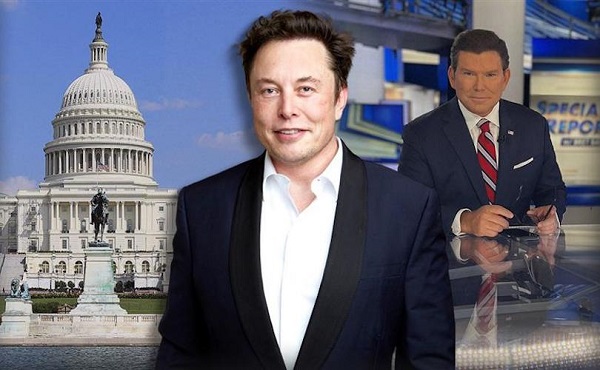Business
Elon Musk, DOGE officials reveal ‘astonishing’ government waste, fraud in viral interview

From LifeSiteNews
Elon Musk said that ‘the sheer amount of waste and fraud’ in federal agencies, is ‘astonishing’ and that DOGE is cutting ‘$4 billion a day’ in misused taxpayer funds.
In a remarkable Fox News interview, Department of Government Efficiency (DOGE) founder Elon Musk and top officials of the DOGE team offered stunning, often infuriating, insights into how the federal government functions.
The interview, which has garnered well over 10 million online views on X in less than 24 hours, provided one extreme example after another of government mismanagement, excess, waste, and fraud while simultaneously promising a future where the D.C. Leviathan is tamed and restored to its proper, efficient role.
The new Deputy Director of the Office of Management and Budget (OMB), former U.S. House Rep. Dan Bishop, averred that the DOGE A-Team interview was the “most amazing and significant half-hour in TV history.”
Musk was joined by DOGE team members Steve Davis, Joe Gebbia, Aram Moghaddassi, Brad Smith, Anthony Armstrong, Tom Krause, and Tyler Hassen – all successful businessmen and entrepreneurs in their own rights – to describe the widespread systemic weaknesses and failures at the Internal Revenue Service (IRS), the National Institutes of Health (NIH), the Department of Health and Human Services (HHS), the Social Security Administration (SSA), and more.
Fox host Bret Baier described the group as “Silicon Valley colliding with government.”
“This is a revolution. And I think it might be the biggest revolution in government since the original revolution,” said Musk during the discussion.
“But at the end of the day, America’s going to be in much better shape,” he promised.
“America will be solvent. The critical programs that people depend upon will work, and it’s going to be a fantastic future.”
My interview with the @elonmusk and the @DOGE team tonight on #SpecialReport pic.twitter.com/KKpxEPtu1Z
— Bret Baier (@BretBaier) March 27, 2025
“The government is not efficient, and there’s a lot of waste and fraud. So we feel confident that a 15% reduction can be done without affecting any of the critical government services,” began Musk, founder and CEO of both Tesla and SpaceX and owner of X.
Musk said that the most stunning thing he’s discovered during the early phases of DOGE is “the sheer amount of waste and fraud in government. It is astonishing. It’s mind-blowing.”
Musk cited the example of a simple 10-question National Park online survey for which the government was charged nearly $1 billion and which in the end served no purpose.
“I think we will accomplish most of the work required to reduce the deficit by a trillion dollars within [130 days],” he predicted. “Our goal is to reduce the waste and fraud by $4 billion a day, every day, seven days a week. And so far, we are succeeding.”
Billionaire Airbnb co-founder Joe Gebbia, is working to digitize the retirement process for government employees, which is currently stuck using 1950s technology, housed in a Pennsylvania cave.
“It’s an injustice to civil servants who are subjected to these processes that are older than the age of half the people watching the show tonight,” said Gebbia. “We really believe that the government can have an Apple store-like experience, beautifully designed, great user experience, modern systems.”
“The retirement process is all by paper, literally, with people carrying paper and manila envelopes into this gigantic mine,” added Musk, limiting the number of federal employees who can retire to no more than 8,000 per month.
Gebbia expects to have the antiquated system updated and overhauled in a matter of months.
“The two improvements that we’re trying to make to Social Security are helping people that legitimately get benefits protect them from fraud that they experience every day on a routine basis and also make the experience better,” said DOGE software engineer Aram Moghaddassi.
He offered an amazing statistic: “When you want to change your (direct deposit) bank account, you can call Social Security. We learned 40% of the phone calls that they get are from fraudsters” who are attempting to commandeer retired seniors’ benefit payments.
“What we’re doing will help their benefits,” assured Musk. “As a result of the work of DOGE, legitimate recipients of social security will receive more money, not less money.”
“There are over 15 million people that are over the age of 120 that are marked as alive in the Social Security system,” said Steve Davis, who has previously worked alongside Musk at SpaceX, the Boring Company, and X
He explained that despite this being discovered by hardworking personnel at the SSA back in 2008, nothing was done. As a result, 15-20 million social security numbers that were clearly fraudulent were just floating around, susceptible to being used for “bad intentions.”
Health care entrepreneur Brad Smith, who has taken charge of auditing HHS and NIH, also cited stunning, troubling statistics displaying the extreme inefficiencies of the nation’s top federal health organizations.
Smith said that at NIH, “Today they have 27 different centers” created by Congress over the years and there are “700 different IT systems,” each using their own IT software.
“They have 27 different CIOs (Chief Information Officers),” added Smith, “so when you think about making great medical discoveries, you have to connect the data.”
Those discoveries are likely severely hampered by NIH’s communications disconnect.
Anthony Armstrong, a Morgan Stanley banker now working for DOGE at the Office of Personnel Management (OPM) talked about “duplicative functions” and “overstaffing” at government agencies. He said that money is “sloshing out the door.”
As an example, he cited the IRS, which has 1,400 employees whose only job is to provision laptops and cell phones to IRS workers.
“As an ex-CFO of a big public tech company, really what we’re doing is, we’re applying public company standards to the federal government, and it is alarming how the financial operations and financial management is set up today,” said Tom Krause, CEO of Cloud Software Group.
He explained that there is virtually no accountability or verification protections when it comes to the Treasury Department disbursing funds to various government agencies.
A 94-year-old grandmother is no longer “going to be robbed by forces like she’s getting robbed today, and the solvency of the federal government will ensure that she continues to receive those social security checks,” added Musk.
“The reason we’re doing this is because if we don’t do it, America is going to go insolvent and go bankrupt, and nobody’s going to get anything,” said Musk.
Tyler Hassen, a former oil executive working at the Interior Department for DOGE alleged that there was no departmental oversight at the Interior Department “whatsoever” under the Biden administration.
Steve Davis talked about the out-of-control issuance and use of federal credit cards.
“There are in the federal government around 4.6 million credit cards for around 2.3 to 2.4 million employees. This doesn’t make sense. So, one of the things all of the teams have worked on is we’ve worked for the agencies and said, ‘Do you need all of these credit cards? Are they being used? Can you tell us physically where they are?’” recounted Davis.
“Clearly there should not be more credit cards than there are people,” interjected Musk.
Musk later described how the Small Business Administration (SBA) has given out $300 million in loans to people “under the age of 11.” An additional $300 million in loans has been handed out to people “over the age of 120.”
Musk said that these government loans are clearly “fraudulent.”
“Terrible things are being done,” he exclaimed. “We’re stopping it.”
Business
Is Government Inflation Reporting Accurate?


 David Clinton
David Clinton
Who ya gonna believe: official CPI figures or your lyin’ eyes?
Great news! We’ve brought inflation back under control and stuff is now only costing you 2.4 percent more than it did last year!
That’s more or less the message we’ve been hearing from governments over the past couple of years. And in fact, the official Statistics Canada consumer price index (CPI) numbers do show us that the “all-items” index in 2024 was only 2.4 percent higher than in 2023. Fantastic.
So why doesn’t it feel fantastic?
Well statistics are funny that way. When you’ve got lots of numbers, there are all kinds of ways to dress ‘em up before presenting them as an index (or chart). And there really is no one combination of adjustments and corrections that’s definitively “right”. So I’m sure Statistics Canada isn’t trying to misrepresent things.
But I’m also curious to test whether the CPI is truly representative of Canadians’ real financial experiences. My first attempt to create my own alternative “consumer price index”, involved Statistics Canada’s “Detailed household final consumption expenditure”. That table contains actual dollar figures for nation-wide spending on a wide range of consumer items. To represent the costs Canadian’s face when shopping for basics, I selected these nine categories:
- Food and non-alcoholic beverages
- Clothing and footwear
- Housing, water, electricity, gas and other fuels
- Major household appliances
- Pharmaceutical products and other medical products (except cannabis)
- Transport
- Communications
- University education
- Property insurance
I then took the fourth quarter (Q4) numbers for each of those categories for all the years between 2013 and 2024 and divided them by the total population of the country for each year. That gave me an accurate picture of per capita spending on core cost-of-living items.
Overall, living and breathing through Q4 2013 would have cost the average Canadian $4,356.38 (or $17,425.52 for a full year). Spending for those same categories in Q4 2024, however, cost us $6,266.48 – a 43.85 percent increase.
By contrast, the official CPI over those years rose only 31.03 percent. That’s quite the difference. Here’s how the year-over-year changes in CPI inflation vs actual spending inflation compare:
As you can see, with the exception of 2020 (when COVID left us with nothing to buy), the official inflation number was consistently and significantly lower than actual spending. And, in the case of 2021, it was more than double.
Since 2023, the items with the largest price growth were university education (57.46 percent), major household appliances (52.67 percent), and housing, water, electricity, gas, and other fuels (50.79).
Having said all that, you could justifiably argue that the true cost of living hasn’t really gone up that much, but that at least part of the increase in spending is due to a growing taste for luxury items and high volume consumption. I can’t put a precise number on that influence, but I suspect it’s not trivial.
Since data on spending doesn’t seem to be the best measure of inflation, perhaps I could build my own basket of costs and compare those numbers to the official CPI. To do that, I collected average monthly costs for gasoline, home rentals, a selection of 14 core grocery items, and taxes paid by the average Canadian homeowner.¹ I calculated the tax burden (federal, provincial, property, and consumption) using the average of the estimates of two AI models.
How did the inflation represented by my custom basket compare with the official CPI? Well between 2017 and 2024, the Statistics Canada’s CPI grew by 23.39 percent. Over that same time, the monthly cost of my basket grew from $4,514.74 to $5,665.18; a difference of 25.48 percent. That’s not nearly as dramatic a difference as we saw when we measured spending, but it’s not negligible either.
The very fact that the government makes all this data freely available to us is evidence that they’re not out to hide the truth. But it can’t hurt to keep an active and independent eye on them, too.
Subscribe to The Audit.
For the full experience, upgrade your subscription.
2025 Federal Election
Carney’s Hidden Climate Finance Agenda

From Energy Now
By Tammy Nemeth and Ron Wallace
It is high time that Canadians discuss and understand Mark Carney’s avowed plan to re-align capital with global Net Zero goals.
Mark Carney’s economic vision for Canada, one that spans energy, housing and defence, rests on an unspoken, largely undisclosed, linchpin: Climate Finance – one that promises a Net Zero future for Canada but which masks a radical economic overhaul.
Regrettably, Carney’s potential approach to a Net Zero future remains largely unexamined in this election. As the former chair of the Glasgow Financial Alliance for Net Zero (GFANZ), Carney has proposed new policies, offices, agencies, and bureaus required to achieve these goals.. Pieced together from his presentations, discussions, testimonies and book, Carney’s approach to climate finance appears to have four pillars: mandatory climate disclosures, mandatory transition plans, centralized data sharing via the United Nations’ Net Zero Data Public Utility (NZDPU) and compliance with voluntary carbon markets (VCMs). There are serious issues for Canada’s economy if these principles were to form the core values for policies under a potential Liberal government.
About the first pillar Carney has been unequivocal: “Achieving net zero requires a whole economy transition.” This would require a restructuring energy and financial systems to shift away from fossil fuels to renewable energy with Carney insisting repeatedly in his book that “every financial [and business] decision takes climate change into account.” Climate finance, unlike broader sustainable finance with its Environmental, Social, and Governance (ESG) focus would channel capital into sectors aligned with a 2050 Net Zero trajectory. Carney states: “Companies, and those who invest in them…who are part of the solution, will be rewarded. Those lagging behind…will be punished.” In other words, capital would flow to compliant firms but be withheld from so-called “high emitters”.
How will investors, banks and insurers distinguish solution from problem? Mandatory climate disclosures, aligned with the International Sustainability Standards Board (ISSB), would compel firms to report emissions and outline their Net Zero strategies. Canada’s Sustainability Standards Board has adopted these methodologies, despite concerns they would disadvantage Canadian businesses. Here, Carney repeatedly emphasizes disclosures as the cornerstone to track emissions data required to shift capital away from “high emitters”. Without this, he claims, large institutional investors lack the data on supply chains to make informed decisions to shift capital to businesses that are Net Zero compliant.
The second pillar, Mandatory Transition Plans would require companies to map a 2050 Net Zero trajectory for emission reduction targets. Failure to meet those targets would invite pressure from investors, banks, or activists, who may pursue litigation for non-compliance. The UK’s Transition Plan Task Force, now part of ISSB, provides this standardized framework. Carney, while at GFANZ, advocated using transition plans for a “managed phase-out” of high-emitting assets like coal, oil and gas, not just through divestment but by financing emissions reductions. “As part of their transition planning, [GFANZ] members should establish and apply financing policies to phase out and align carbon-intensive sectors and activities, such as thermal coal, oil and gas and deforestation, not only through asset divestment but also through transition finance that reduces real world emissions. To assist with these efforts GFANZ will continue to develop and implement a framework for the Managed Phase-out of high-emitting assets.” Clearly, the purpose of this is to ensure companies either decarbonize or face capital withdrawal.
The third pillar is the United Nations’ Net Zero Data Public Utility (NZDPU), a centralized platform for emissions and transition data. Carney insists these data be freely accessible, enabling investors, banks and insurers to judge companies’ progress to Net Zero. As Carney noted in 2021: “Private finance is judging…banks, pension funds and asset managers have to show where they are in the transition to Net Zero.” Hence, compliant firms would receive investment; laggards would face divestment.
Finally, voluntary carbon markets (VCMs) allow companies to offset emissions by purchasing credits from projects like reforestation. Carney, who launched the Taskforce on Scaling VCMs in 2020, has insisted on monitoring, verification and lifecycle tracking. At a 2024 Beijing conference, he suggested major jurisdictions could establish VCMs by COP 30 (planned for 2025 in Brazil) to create a global market. If Canada mandates VCMs, businesses especially small and medium enterprises (SMEs) would face much higher compliance costs with credits available only to those that demonstrate progress with transition plans.
These potential mandatory disclosures and transition plans would burden Canadian businesses with material costs and legal risks that constitute an economic gamble which few may recognize but all should weigh. Do Canadians truly want a government that has an undisclosed climate finance agenda that would be subservient to an opaque globalized Net Zero agenda?
Tammy Nemeth is a U.K.-based strategic energy analyst. Ron Wallace is an executive fellow of the Canadian Global Affairs Institute and the Canada West Foundation.
-

 2025 Federal Election6 hours ago
2025 Federal Election6 hours agoStudy links B.C.’s drug policies to more overdoses, but researchers urge caution
-

 conflict1 day ago
conflict1 day agoMarco Rubio says US could soon ‘move on’ from Ukraine conflict: ‘This is not our war’
-

 Business22 hours ago
Business22 hours agoChinese firm unveils palm-based biometric ID payments, sparking fresh privacy concerns
-

 2025 Federal Election1 day ago
2025 Federal Election1 day agoPolice Associations Endorse Conservatives. Poilievre Will Shut Down Tent Cities
-

 Alberta1 day ago
Alberta1 day agoRed Deer Justice Centre Grand Opening: Building access to justice for Albertans
-

 International2 days ago
International2 days agoNew York Times publishes chilling new justification for assisted suicide
-

 2025 Federal Election2 days ago
2025 Federal Election2 days agoMark Carney Wants You to Forget He Clearly Opposes the Development and Export of Canada’s Natural Resources
-

 2025 Federal Election21 hours ago
2025 Federal Election21 hours agoFormer WEF insider accuses Mark Carney of using fear tactics to usher globalism into Canada







